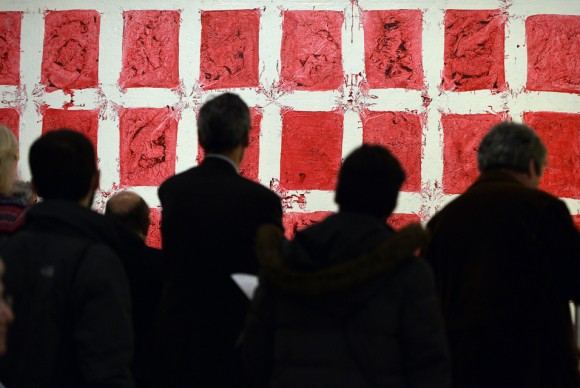First important Italian retrospective dedicated to Simon Hantaï opens at Villa Medici
February 13, 2014 by All Art News
Filed under Art Events & Exhibitions, Featured
ROME.- From 12 February to 11 May 2014 the French Academy in Rome – Villa Medici is presenting the first important Italian retrospective dedicated to Simon Hantaï, curated by Éric de Chassey.
This exhibition has been devised and realized six years after the artist’s death in cooperation with the Centre Georges Pompidou, following the exhibition presented there from 22 May to 2 September 2013, which was curated by Dominique Fourcade, Isabelle Monod Fontaine and Alfred Pacquement, former director of the Musée National d’Art Moderne – Centre de Création Industrielle.

Visitors look at a painting by Simon Hantai (1922-2008) during the media day of a retrospective of the Hungarian-born, French painter on February 11, 2014 at the Villa Medici, the French Academy in Rome. The exhibition has been devised and realized in cooperation with the Centre Georges Pompidou museum in Paris and will be open from February 12 to May 11, 2014 to give the public a chance to see the works of this protagonist of abstractionism. AFP PHOTO / GABRIEL BOUYS.
It is now Villa Medici’s turn to give the public a chance to explore the works of this late twentieth century protagonist of abstractionism, who chose to live in Paris after a one-year sojourn in Italy.
Éric de Chassey explains: “After visiting Hantaï’s first important posthumous retrospective I decided to bring about its Roman extension. […] First of all because very few artists succeed in combining art and thought, secondly because showing Hantaï’s work in Italy means returning him to one of the places which contributed to his birth as an artist following his 1948 sojourn, after having lived between Hungary, his homeland, and France, his adopted country. […] We would like to express how, in order to continue painting, Hantaï found himself forced to open up his art to something it was not (in particular writing, photography and philosophy), while mortifying and reducing painting to its basest material components – thus paradoxically enabling it to flourish in prodigious splendour”.
Forty various sized paintings realized between 1958 and 2004 will be displayed in the Grandes Galeries of Villa Medici. Approaching Hantaï’s work today, exacts confrontation with the tension that drove him to the idea of isolation after he had represented France at the 1982 Venice Biennale. His attitude was in striking contrast to the universe of appearance and ‘visibility’ that is so widespread in contemporary culture. Hantaï’s vocation was to regain possession of absolute research as the final objective and mission of an artist, which was to become the distinctive characteristic of his life and work during his last years. This period is witness to works – some of which never shown before – which embody the dialogue of Hantaï with the greatest philosophers and writers of his time such as Jacques Derrida, Jean-Luc Nancy, Hélène Cixous and Dominique Fourcade.
The exhibition at Villa Medici will enable the Italian and international public to become acquainted with Hantaï’s experimental painting, his rejection of celebration, his profound intellectual motivations and the echoes of his surrealist experience. And also, with his relationship with matter that continually evolves in experimentation, manipulation, and original techniques: collage, tracing, pliage (folding) that had so fascinated Deleuze, découpage, trials with diverse materials. The exhibition also presents various works from Hantaï’s ‘writing’ period, based on a highly disciplined calligraphic experience which became his existential palimpsest and aesthetic canon, as a form of submission to the absolute while being a silent provocation.
The retrospective is further enhanced by the presentation of the great Mariale conserved in the Vatican Museums, which was not exhibited at the Centre Pompidou and is part of the a great series developed by Hantaï between 1960 and 1962.
The exhibition is divided into two sections linked by a selection of small paintings that helps understanding the artist’s itinerary in the 1960s and 1970s. In the first part, surrounding the monumental achievements of Peinture (Écriture rose) and À Galla Placidia (1958-1959), are paintings created by small strokes or calligraphy, as well as works realized with the pliage technique, such as the first Mariales which constitute Hantaï’s answer to the work of Matisse and Pollock.
The second section of the exhibition contains the Tabulas series, realized from 1974 to 1982, prior to the Laissées (1981-1994). Following his participation in the 1982 Venice Biennale, Hantaï decided to retire from the art world opposing a radical provocation, in the works of his last years, by cutting or even destroying previous pictures .
The exhibition terminates with the works from the Pliages à usage domestique series, many of which have never been shown to the public before. Here, the artist revisits some of his youthful intuitions, especially those he had at the beginning of the 1950s, which reveal his bond to Marcel Duchamp’s artistic research.
Simon Hantaï was born in Hungary in 1922. He attended the Academy of Fine Arts in Budapest. After a one-year sojourn in Italy, he moved to France in 1948 where he encountered André Breton, who organized his first exhibition in 1953. Close to the Surrealist movement, Hantaï was initially considered to be the great new painter of the movement by Breton, although he drifted away to develop his personal abstract style in the 1950s. Simon Hantaï is known as the master of ‘folding as method [pliage comme method]’, the technique he created in 1960. He represented France at the Venice Biennale in 1982. The Centre Georges Pompidou in Paris dedicated two retrospectives to the artist in 1976 and 2013. Important collection of his works are hold by the Centre Pompidou and the Musée d’Art Moderne de la Ville de Paris.
